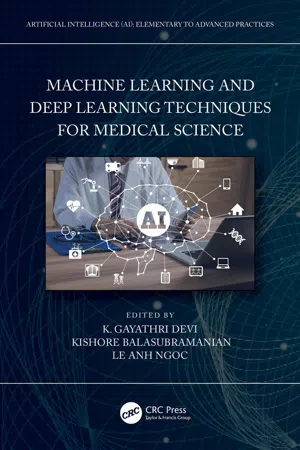
Machine Learning and Deep Learning Techniques for Medical Science
- 410 pages
- English
- ePUB (mobile friendly)
- Available on iOS & Android
Machine Learning and Deep Learning Techniques for Medical Science
About this book
The application of machine learning is growing exponentially into every branch of business and science, including medical science. This book presents the integration of machine learning (ML) and deep learning (DL) algorithms that can be applied in the healthcare sector to reduce the time required by doctors, radiologists, and other medical professionals for analyzing, predicting, and diagnosing the conditions with accurate results. The book offers important key aspects in the development and implementation of ML and DL approaches toward developing prediction tools and models and improving medical diagnosis.
The contributors explore the recent trends, innovations, challenges, and solutions, as well as case studies of the applications of ML and DL in intelligent system-based disease diagnosis. The chapters also highlight the basics and the need for applying mathematical aspects with reference to the development of new medical models. Authors also explore ML and DL in relation to artificial intelligence (AI) prediction tools, the discovery of drugs, neuroscience, diagnosis in multiple imaging modalities, and pattern recognition approaches to functional magnetic resonance imaging images.
This book is for students and researchers of computer science and engineering, electronics and communication engineering, and information technology; for biomedical engineering researchers, academicians, and educators; and for students and professionals in other areas of the healthcare sector.
- Presents key aspects in the development and the implementation of ML and DL approaches toward developing prediction tools, models, and improving medical diagnosis
- Discusses the recent trends, innovations, challenges, solutions, and applications of intelligent system-based disease diagnosis
- Examines DL theories, models, and tools to enhance health information systems
- Explores ML and DL in relation to AI prediction tools, discovery of drugs, neuroscience, and diagnosis in multiple imaging modalities
Dr. K. Gayathri Devi is a Professor at the Department of Electronics and Communication Engineering, Dr. N.G.P Institute of Technology, Tamil Nadu, India.
Dr. Kishore Balasubramanian is an Assistant Professor (Senior Scale) at the Department of EEE at Dr. Mahalingam College of Engineering & Technology, Tamil Nadu, India.
Dr. Le Anh Ngoc is a Director of Swinburne Innovation Space and Professor in Swinburne University of Technology (Vietnam).
Frequently asked questions
- Essential is ideal for learners and professionals who enjoy exploring a wide range of subjects. Access the Essential Library with 800,000+ trusted titles and best-sellers across business, personal growth, and the humanities. Includes unlimited reading time and Standard Read Aloud voice.
- Complete: Perfect for advanced learners and researchers needing full, unrestricted access. Unlock 1.4M+ books across hundreds of subjects, including academic and specialized titles. The Complete Plan also includes advanced features like Premium Read Aloud and Research Assistant.
Please note we cannot support devices running on iOS 13 and Android 7 or earlier. Learn more about using the app.
Information
1 A Comprehensive Study on MLP and CNN, and the Implementation of Multi-Class Image Classification using Deep CNN
- 1.1 Introduction
- 1.2 The Processes of the Neural Network
- 1.2.1 Basics of Neural Network
- 1.2.1.1 Architecture of Neural Network
- 1.2.1.2 Working Principles of Neural Network
- 1.2.1.3 Learning Methods of Neural Network
- 1.2.1.4 Drawbacks of Neural Network
- 1.2.2 Convolutional Neural Network (CNN) Algorithm
- 1.2.2.1 Merits of CNN over MLP
- 1.2.2.2 Contents of CNN
- 1.2.2.3 Working of CNN Algorithm
- 1.2.2.4 Deep CNN
- 1.3 Experimental Procedure
- 1.3.1 Preparing the Dataset
- 1.3.2 Model Training and Testing
- 1.4 Results and Discussion
- 1.4.1 MNIST Dataset Image Classifications
- 1.4.2 CIFAR-10 Dataset Image Classifications
- 1.5 Conclusion
- References
1.1 Introduction
Table of contents
- Cover
- Half Title
- Series Page
- Title Page
- Copyright Page
- Contents
- Editor Biographies
- List of Contributors
- Chapter 1 A Comprehensive Study on MLP and CNN, and the Implementation of Multi-Class Image Classification using Deep CNN
- Chapter 2 An Efficient Technique for Image Compression and Quality Retrieval in Diagnosis of Brain Tumour Hyper Spectral Image
- Chapter 3 Classification of Breast Thermograms using a Multi-layer Perceptron with Back Propagation Learning
- Chapter 4 Neural Networks for Medical Image Computing
- Chapter 5 Recent Trends in Bio-Medical Waste, Challenges and Opportunities
- Chapter 6 Teager-Kaiser Boost Clustered Segmentation of Retinal Fundus Images for Glaucoma Detection
- Chapter 7 IoT-Based Deep Neural Network Approach for Heart Rate and SpO2 Prediction
- Chapter 8 An Intelligent System for Diagnosis and Prediction of Breast Cancer Malignant Features using Machine Learning Algorithms
- Chapter 9 Medical Image Classification with Artificial and Deep Convolutional Neural Networks: A Comparative Study
- Chapter 10 Convolutional Neural Network for Classification of Skin Cancer Images
- Chapter 11 Application of Artificial Intelligence in Medical Imaging
- Chapter 12 Machine Learning Algorithms Used in Medical Field with a Case Study
- Chapter 13 Dual Customized U-Net-based Based Automated Diagnosis of Glaucoma
- Chapter 14 MuSCF-Net: Multi-scale, Multi-Channel Feature Network using Resnet-Based Attention Mechanism for Breast Histopathological Image Classification
- Chapter 15 Artificial Intelligence is Revolutionizing Cancer Research
- Chapter 16 Deep Learning to Diagnose Diseases and Security in 5G Healthcare Informatics
- Chapter 17 New Approaches in Machine-based Image Analysis for Medical Oncology
- Chapter 18 Performance Analysis of Deep Convolutional Neural Networks for Diagnosing COVID-19: Data to Deployment
- Chapter 19 Stacked Auto Encoder Deep Neural Network with Principal Components Analysis for Identification of Chronic Kidney Disease
- Index